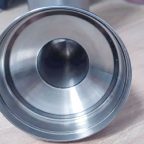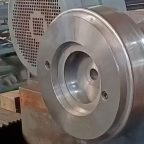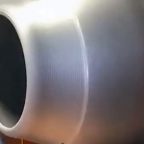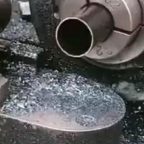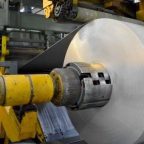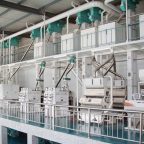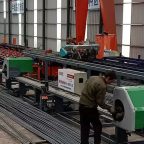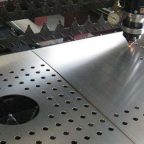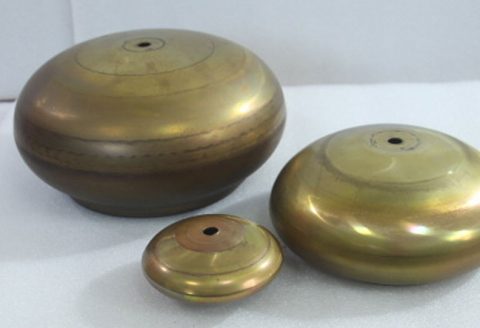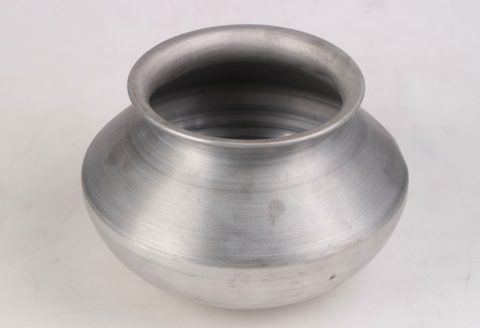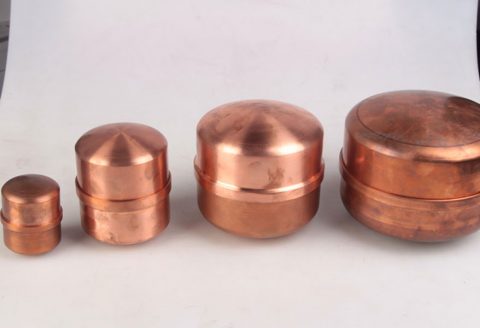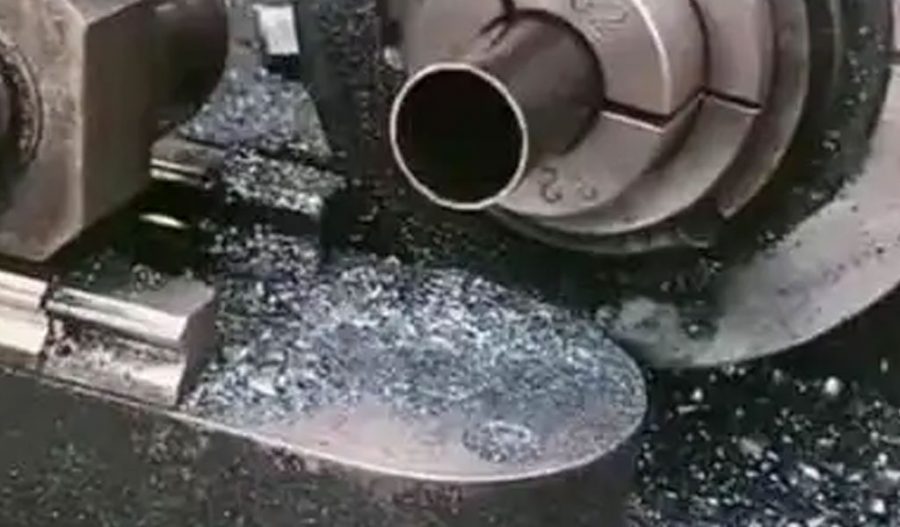
High manganese (Mn) steels, characterized by their exceptional mechanical properties, have garnered significant attention in industries requiring materials with high strength, ductility, and toughness, particularly under extreme conditions such as cryogenic temperatures. These steels, often containing 15–30 wt% manganese, exhibit unique deformation mechanisms, including transformation-induced plasticity (TRIP) and twinning-induced plasticity (TWIP), which contribute to their remarkable performance. The ability of high manganese steels to maintain structural integrity and deformability in extreme low-temperature environments (below -150°C, or approximately 123 K) makes them ideal candidates for applications in liquefied natural gas (LNG) storage tanks, aerospace components, and polar infrastructure. This article comprehensively explores the spinning forming behavior and phase transformation strengthening mechanisms of high manganese steel under such extreme conditions, integrating insights from microstructural evolution, mechanical properties, and processing techniques.
Spinning forming, a metalworking process involving the incremental deformation of a rotating workpiece, is widely used to produce axisymmetric components with high precision and minimal material waste. The process is particularly challenging at cryogenic temperatures due to changes in material flow behavior, phase stability, and deformation mechanisms. High manganese steels, with their austenitic microstructure and low stacking fault energy (SFE), undergo complex phase transformations under deformation, including the formation of ε-martensite (hexagonal close-packed, HCP) and α’-martensite (body-centered cubic, BCC), alongside mechanical twinning. These transformations are highly sensitive to temperature, strain rate, and alloy composition, making the study of spinning forming under extreme low temperatures both scientifically intriguing and industrially relevant.
This article synthesizes current research on the spinning forming behavior of high manganese steels, focusing on the interplay between deformation processes and phase transformations at cryogenic temperatures. It examines the influence of alloying elements, processing parameters, and microstructural evolution on mechanical properties, supported by detailed tables comparing experimental data. The discussion is structured to provide a scientific overview, addressing fundamental mechanisms, experimental methodologies, and potential applications, while maintaining a neutral and objective tone.
Fundamentals of High Manganese Steel
Composition and Microstructure
High manganese steels typically contain 15–30 wt% manganese, 0.1–1.2 wt% carbon, and alloying elements such as aluminum (Al), silicon (Si), chromium (Cr), and niobium (Nb). These elements modulate the stacking fault energy (SFE), which governs the dominant deformation mechanisms. The SFE, typically ranging from 10 to 60 mJ/m² in high manganese steels, determines whether the material undergoes dislocation glide, mechanical twinning (TWIP effect), or martensitic transformation (TRIP effect). At cryogenic temperatures, the SFE decreases, promoting strain-induced phase transformations from face-centered cubic (FCC) austenite (γ) to HCP ε-martensite and, subsequently, BCC α’-martensite.
The austenitic microstructure of high manganese steels is stable at room temperature due to the high manganese content, which expands the austenite phase field. However, under deformation, particularly at low temperatures, the austenite becomes metastable, facilitating phase transformations. These transformations enhance strength and ductility through the TRIP effect, where the formation of martensite absorbs energy and delays necking, or the TWIP effect, where deformation twins increase work hardening.
Stacking Fault Energy and Deformation Mechanisms
The SFE is a critical parameter influencing the deformation behavior of high manganese steels. It is defined as the energy required to form a stacking fault in the FCC lattice, which affects the ease of twinning or martensitic transformation. The SFE is influenced by temperature, alloy composition, and grain size. At cryogenic temperatures (e.g., -150°C or 123 K), the SFE typically drops below 20 mJ/m², favoring the γ → ε → α’ transformation sequence. This is in contrast to higher temperatures (e.g., 20°C), where SFE values of 20–60 mJ/m² promote twinning, and above 60 mJ/m², dislocation glide dominates.
Manganese increases the SFE, stabilizing austenite and promoting twinning over martensitic transformation. Aluminum further increases SFE, suppressing the γ → ε transformation, while silicon reduces SFE, enhancing martensite formation. Carbon strengthens the austenite matrix through solid solution strengthening and influences the SFE, with higher carbon contents promoting twinning. These compositional effects are crucial in tailoring high manganese steels for specific applications, particularly under extreme conditions.
Cryogenic Applications
High manganese steels are particularly suited for cryogenic applications due to their ability to maintain toughness and ductility at low temperatures. Unlike conventional steels, which exhibit a ductile-to-brittle transition, high manganese steels retain their austenitic structure or undergo controlled phase transformations, preventing brittle fracture. Applications include LNG storage tanks, where temperatures reach -162°C (111 K), and structural components in polar environments, where temperatures can drop below -50°C (223 K). The spinning forming process is relevant for producing seamless pipes, pressure vessels, and other components used in these applications, necessitating a deep understanding of material behavior under such conditions.
Spinning Forming Process
Overview of Spinning Forming
Spinning forming is a versatile metalworking technique that involves rotating a workpiece (typically a metal sheet or tube) while applying localized pressure with a roller or tool to shape it into an axisymmetric component. The process can be classified into conventional spinning, shear spinning, and tube spinning, depending on the deformation mode and workpiece geometry. In conventional spinning, the material is incrementally deformed without significant thickness reduction, while shear spinning reduces thickness to achieve precise shapes. Tube spinning is used to form cylindrical components, such as pipes, by reducing the diameter or wall thickness.
The process is characterized by complex stress states, including compressive, tensile, and shear stresses, which vary across the workpiece. The incremental nature of spinning allows for high formability, making it suitable for high manganese steels, which exhibit excellent ductility. However, at cryogenic temperatures, the material’s flow behavior changes due to reduced thermal activation, increased strength, and phase transformations, posing challenges for process control.
Challenges at Cryogenic Temperatures
Spinning forming at extreme low temperatures introduces several challenges:
- Increased Flow Stress: As temperature decreases, the yield strength and flow stress of high manganese steels increase due to reduced dislocation mobility and enhanced phase transformations. This requires higher forming forces, impacting tool design and energy requirements.
- Phase Transformations: The low SFE at cryogenic temperatures promotes strain-induced martensitic transformations, altering the material’s flow behavior and work hardening rate during spinning.
- Tool-Material Interaction: Cryogenic conditions affect the friction and wear characteristics at the tool-workpiece interface, necessitating specialized lubricants or coatings.
- Microstructural Evolution: The interplay of deformation twinning and phase transformations during spinning influences the final microstructure, affecting mechanical properties.
Process Parameters
Key parameters in spinning forming include roller feed rate, spindle speed, roller geometry, and deformation temperature. At cryogenic temperatures, these parameters must be optimized to balance formability and strength. For instance, a lower feed rate may be required to accommodate the increased flow stress, while spindle speed influences adiabatic heating, which can locally alter the SFE and phase transformation behavior.
Phase Transformation Strengthening Mechanisms
Transformation-Induced Plasticity (TRIP)
The TRIP effect involves the strain-induced transformation of metastable austenite into ε-martensite and/or α’-martensite during deformation. This transformation enhances strength by introducing hard martensitic phases and improves ductility by delaying necking through localized strain hardening. At cryogenic temperatures, the TRIP effect is pronounced due to the low SFE, which facilitates the γ → ε → α’ transformation sequence. The ε-martensite forms as thin, hexagonal laths within the austenite matrix, acting as nucleation sites for the harder α’-martensite.
The volume fraction of transformed martensite depends on strain, temperature, and alloy composition. For example, a high manganese steel with 20 wt% Mn and 0.6 wt% C may exhibit 30–50% ε-martensite and 10–20% α’-martensite after 10% tensile strain at -150°C. The transformation is governed by the following crystallographic relationships:
- γ → ε: {111}γ || {0001}ε, <110>γ || <1120>ε
- ε → α’: {0001}ε || {101}α’, <1120>ε || <111>α’
These relationships ensure coherent interfaces, minimizing energy barriers and facilitating transformation.
Twinning-Induced Plasticity (TWIP)
The TWIP effect occurs when deformation twins form within the austenite matrix, acting as barriers to dislocation motion and increasing work hardening. Twins are thin, nanoscale lamellae formed by the glide of partial dislocations on {111} planes. At cryogenic temperatures, twinning is less dominant than martensitic transformation due to the low SFE, but it remains significant in steels with higher manganese or aluminum content, where SFE ranges from 20–40 mJ/m².
Twinning enhances ductility by providing additional deformation modes and contributes to strength through dynamic Hall-Petch strengthening, where twin boundaries refine the effective grain size. The twin volume fraction increases with strain, and at cryogenic temperatures, the twin thickness and spacing decrease, leading to a finer microstructure and higher strength.
Interaction of TRIP and TWIP
In high manganese steels, TRIP and TWIP mechanisms often coexist, with their relative contributions determined by SFE. At cryogenic temperatures, the low SFE favors TRIP, but twinning can occur in the early stages of deformation or in alloys with tailored compositions. The interaction between twinning and martensitic transformation is complex:
- Twinning as a Precursor: Deformation twins can act as nucleation sites for ε-martensite, as their faulted structure lowers the energy barrier for transformation.
- Martensite-Twin Competition: At higher strains, the formation of martensite may suppress twinning by consuming austenite, reducing the available matrix for twin formation.
- Strain Hardening: Both mechanisms contribute to high work hardening rates, with TRIP providing localized strengthening and TWIP enabling sustained ductility.
Role of Alloying Elements
Alloying elements play a critical role in modulating phase transformations:
- Manganese: Increases SFE, stabilizing austenite and promoting twinning. At 15–20 wt%, martensitic transformation dominates at cryogenic temperatures, while at 25–30 wt%, twinning is more prevalent.
- Carbon: Enhances solid solution strengthening and increases SFE, favoring twinning. High carbon contents (e.g., 1.2 wt%) promote deformation twins and improve toughness.
- Aluminum: Increases SFE, suppressing martensitic transformation and enhancing twinning. It also improves corrosion resistance by forming a protective Al₂O₃ layer.
- Silicon: Reduces SFE, promoting martensitic transformation. It also influences inclusion formation, affecting hot ductility.
- Niobium: Inhibits recrystallization, refines grain size, and forms nanoscale carbides (e.g., NbC), contributing to precipitation strengthening.
Experimental Studies on Spinning Forming at Cryogenic Temperatures
Material Preparation
Experimental studies on high manganese steels typically involve laboratory-scale casting followed by thermomechanical processing. A common composition is Fe-20Mn-0.6C-3Al-3Si (wt%), prepared via vacuum induction melting and forged into billets. The billets are hot-rolled to reduce thickness and refine the microstructure, followed by intercritical annealing to stabilize austenite. For cryogenic spinning, samples are cooled to temperatures as low as -196°C (77 K) using liquid nitrogen or specialized cooling systems.
Spinning Forming Setup
Spinning experiments are conducted on CNC-controlled spinning machines equipped with cryogenic cooling systems. The workpiece is mounted on a rotating mandrel, and a roller applies localized pressure to shape the material. Key parameters include:
- Temperature: -150°C to -196°C
- Roller Feed Rate: 0.5–2 mm/rev
- Spindle Speed: 100–500 rpm
- Roller Geometry: Spherical or cylindrical, with diameters of 10–20 mm
The cryogenic environment is maintained using liquid nitrogen baths or cooled mandrels, ensuring uniform temperature distribution. Friction is managed using low-temperature lubricants or coatings to minimize tool wear.
Microstructural Characterization
Microstructural evolution during spinning is characterized using advanced techniques:
- Scanning Electron Microscopy (SEM): Reveals grain morphology, twin formation, and martensite laths.
- Electron Backscatter Diffraction (EBSD): Quantifies phase fractions, crystallographic orientations, and deformation textures.
- Transmission Electron Microscopy (TEM): Identifies nanoscale twins, dislocations, and precipitates.
- X-Ray Diffraction (XRD): Measures phase fractions and lattice parameters, confirming transformation sequences.
For example, a study on Fe-20Mn-3Al-3Si steel deformed at -150°C showed a 40% increase in ε-martensite and a 15% increase in α’-martensite after 10% strain, with twin fractions remaining below 5%. The EBSD analysis confirmed the {111}γ || {0001}ε orientation relationship, indicating coherent transformation.
Mechanical Testing
Mechanical properties are evaluated using tensile, hardness, and impact tests:
- Tensile Testing: Conducted at cryogenic temperatures to measure yield strength (YS), ultimate tensile strength (UTS), and elongation. For instance, Fe-20Mn-0.6C steel exhibited a YS of 800 MPa and UTS of 1200 MPa at -150°C, with 60% elongation.
- Hardness Testing: Vickers or Rockwell hardness tests reveal surface hardening due to martensitic transformation. A hardened layer of 500–700 HV is common after cryogenic spinning.
- Charpy Impact Testing: Assesses toughness, showing that high manganese steels maintain high energy absorption (e.g., 100 J at -196°C) due to the TRIP effect.
Key Findings
- Formability: High manganese steels exhibit excellent formability during spinning at cryogenic temperatures, attributed to the TRIP and TWIP effects. The incremental deformation minimizes cracking, even at high flow stresses.
- Phase Transformation: The γ → ε → α’ transformation is accelerated at lower temperatures, with ε-martensite forming at strains as low as 5%. The α’-martensite contributes to strength but may reduce ductility if excessive.
- Work Hardening: The work hardening rate increases with decreasing temperature due to the combined effects of martensitic transformation and twinning. For example, the work hardening exponent (n) increases from 0.3 at 20°C to 0.5 at -150°C.
- Microstructural Refinement: Spinning refines the grain structure, with twin boundaries and martensite laths reducing the effective grain size, enhancing strength via the Hall-Petch effect.
Comparative Analysis of Spinning Forming Behavior
Influence of Temperature
The deformation temperature significantly affects spinning behavior. At room temperature (20°C), high manganese steels primarily deform via twinning, with limited martensitic transformation. At -150°C, the SFE drops, promoting ε-martensite formation, which enhances strength but may reduce formability if the martensite fraction exceeds 50%. At -196°C, the transformation to α’-martensite dominates, leading to ultrahigh strength (e.g., 1500 MPa UTS) but potential embrittlement.
Table 1: Effect of Temperature on Mechanical Properties and Phase Fractions
| Temperature (°C) | SFE (mJ/m²) | Yield Strength (MPa) | UTS (MPa) | Elongation (%) | Austenite (%) | ε-Martensite (%) | α’-Martensite (%) | Twin Fraction (%) |
|---|---|---|---|---|---|---|---|---|
| 20 | 25 | 400 | 800 | 80 | 90 | 5 | 0 | 5 |
| -50 | 20 | 600 | 1000 | 70 | 80 | 15 | 2 | 3 |
| -150 | 15 | 800 | 1200 | 60 | 60 | 30 | 10 | 2 |
| -196 | 12 | 1000 | 1500 | 50 | 40 | 40 | 20 | 1 |
Note: Data compiled from studies on Fe-20Mn-0.6C-3Al-3Si steel under tensile deformation.
Influence of Manganese Content
Manganese content modulates the SFE and deformation mechanisms. Low manganese steels (e.g., 15 wt%) favor martensitic transformation, while high manganese steels (e.g., 25 wt%) promote twinning. During spinning, higher manganese contents improve formability by reducing the martensite fraction, but lower manganese contents enhance strength.
Table 2: Effect of Manganese Content on Spinning Behavior
| Mn Content (wt%) | SFE (mJ/m²) | Yield Strength (MPa) | UTS (MPa) | Elongation (%) | ε-Martensite (%) | α’-Martensite (%) | Formability Index |
|---|---|---|---|---|---|---|---|
| 15 | 12 | 900 | 1400 | 50 | 40 | 15 | Moderate |
| 20 | 15 | 800 | 1200 | 60 | 30 | 10 | High |
| 25 | 20 | 600 | 1000 | 75 | 15 | 5 | Excellent |
| 30 | 25 | 500 | 900 | 85 | 5 | 0 | Excellent |
Note: Formability index based on crack-free deformation during spinning at -150°C.
Influence of Strain Rate
Spinning involves varying strain rates due to the incremental nature of deformation. Higher strain rates (e.g., 10² s⁻¹) enhance twinning and martensitic transformation, increasing strength but potentially reducing ductility. At cryogenic temperatures, the strain rate sensitivity (SRS) increases, affecting the flow behavior.
Table 3: Effect of Strain Rate on Mechanical Properties at -150°C
| Strain Rate (s⁻¹) | Yield Strength (MPa) | UTS (MPa) | Elongation (%) | ε-Martensite (%) | α’-Martensite (%) |
|---|---|---|---|---|---|
| 10⁻³ | 700 | 1100 | 65 | 25 | 5 |
| 10⁻¹ | 800 | 1200 | 60 | 30 | 10 |
| 10¹ | 900 | 1300 | 55 | 35 | 15 |
| 10² | 1000 | 1400 | 50 | 40 | 20 |
Note: Data for Fe-20Mn-0.6C steel under tensile testing.
Strengthening Mechanisms in Detail
Dislocation Strengthening
Dislocation strengthening arises from the increased dislocation density during deformation, which hinders further dislocation motion. At cryogenic temperatures, the reduced thermal activation limits dislocation annihilation, leading to a high dislocation density (e.g., 10¹⁴ m⁻² after 10% strain). This contributes significantly to yield strength, particularly in the early stages of spinning.
Precipitation Strengthening
Microalloying elements like niobium and vanadium form nanoscale carbides (e.g., NbC, VC) during thermomechanical processing. These precipitates pin dislocations and grain boundaries, enhancing strength. At cryogenic temperatures, the precipitation strengthening effect is amplified due to reduced solubility of carbon and alloying elements, leading to finer precipitates (e.g., 10–50 nm).
Grain Refinement Strengthening
Spinning refines the grain structure through dynamic recrystallization and phase transformation. The formation of martensite laths and twin boundaries reduces the effective grain size, increasing strength via the Hall-Petch relationship:
[ \sigma_y = \sigma_0 + k_y d^{-1/2} ]
where (\sigma_y) is the yield strength, (\sigma_0) is the friction stress, (k_y) is a constant, and (d) is the grain size. A reduction in grain size from 50 μm to 5 μm can increase the yield strength by 200–300 MPa.
Transformation Strengthening
The TRIP effect is the dominant strengthening mechanism at cryogenic temperatures. The formation of ε- and α’-martensite introduces hard phases that increase the flow stress. The transformation also induces volume expansion, creating compressive stresses that enhance work hardening. The strengthening contribution can be quantified using:
[ \Delta\sigma_{TRIP} = k \cdot f_m ]
where (k) is a constant (typically 500–1000 MPa) and (f_m) is the martensite volume fraction.
Twinning Strengthening
Twinning contributes to strength by creating twin boundaries that act as obstacles to dislocation motion. The strengthening effect is described by:
[ \Delta\sigma_{TWIP} = k_t \cdot f_t^{1/2} ]
where (k_t) is a constant and (f_t) is the twin volume fraction. At cryogenic temperatures, the twin fraction is lower, but the finer twin spacing enhances the strengthening effect.
Applications and Industrial Relevance
High manganese steels processed via spinning forming at cryogenic temperatures are ideal for:
- LNG Storage Tanks: Seamless pipes and vessels with high toughness and strength.
- Aerospace Components: Lightweight, high-strength parts for cryogenic fuel systems.
- Polar Infrastructure: Structural components resistant to brittle fracture in extreme cold.
The ability to form complex shapes with minimal defects enhances the economic viability of these steels, reducing material waste and production costs.
Challenges and Future Directions
Challenges
- Process Control: Maintaining uniform cryogenic temperatures during spinning is challenging, as adiabatic heating can locally alter the SFE and phase transformation behavior.
- Tool Wear: High flow stresses and phase transformations increase tool wear, requiring advanced materials or coatings.
- Hydrogen Embrittlement: High manganese steels are susceptible to hydrogen embrittlement in cryogenic environments, particularly in hydrogen-rich applications like LNG systems.
- Cost: The use of cryogenic cooling systems and specialized alloys increases production costs, necessitating cost-effective processing strategies.
Future Directions
- Advanced Alloy Design: Developing alloys with optimized SFE for balanced TRIP and TWIP effects at cryogenic temperatures.
- In-Situ Characterization: Using high-energy X-ray diffraction (HEXRD) to monitor phase transformations during spinning, enabling real-time process optimization.
- Simulation and Modeling: Developing finite element models to predict flow behavior and phase transformations, reducing experimental costs.
- Hybrid Processing: Combining spinning with other techniques (e.g., laser-assisted forming) to enhance formability and reduce tool wear.
Conclusion
The spinning forming behavior and phase transformation strengthening mechanisms of high manganese steels under extreme low-temperature environments represent a critical area of research with significant industrial potential. The interplay of TRIP and TWIP effects, modulated by alloy composition and processing parameters, enables these steels to achieve exceptional strength and ductility. Experimental studies highlight the importance of temperature, strain rate, and manganese content in controlling microstructural evolution and mechanical properties. Detailed tables provide comparative insights into the effects of these parameters, guiding material and process design. As industries increasingly demand materials for extreme environments, high manganese steels processed via cryogenic spinning offer a promising solution, with ongoing research poised to address current challenges and unlock new applications.
Maximize Tooling and CNC Metal Spinning Capabilities.
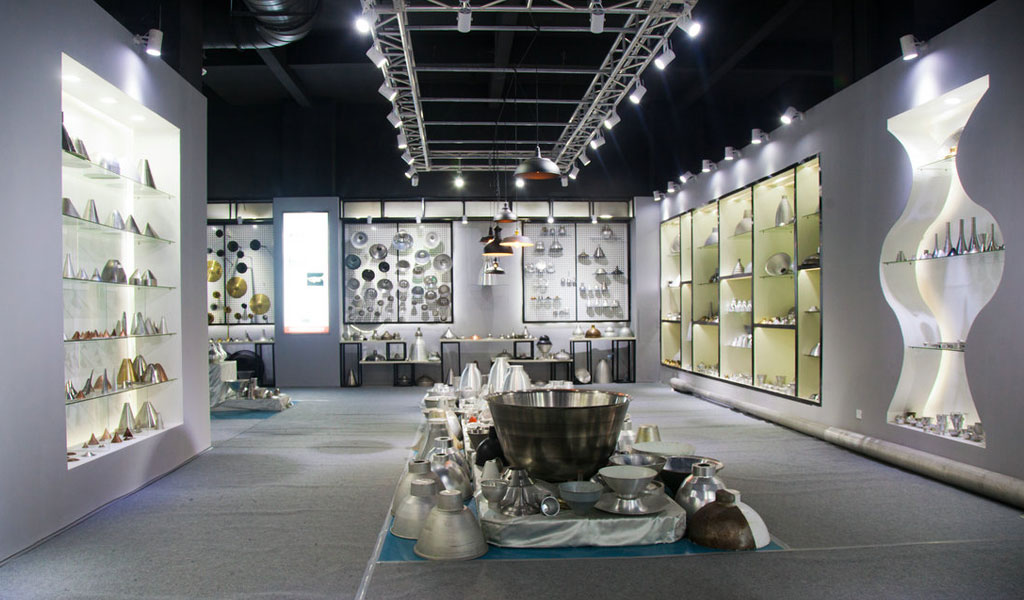
At BE-CU China Metal Spinning company, we make the most of our equipment while monitoring signs of excess wear and stress. In addition, we look into newer, modern equipment and invest in those that can support or increase our manufacturing capabilities. Our team is very mindful of our machines and tools, so we also routinely maintain them to ensure they don’t negatively impact your part’s quality and productivity.
Talk to us today about making a rapid prototype with our CNC metal spinning service. Get a direct quote by chatting with us here or request a free project review.
BE-CU China CNC Metal Spinning service include : CNC Metal Spinning,Metal Spinning Die,Laser Cutting, Tank Heads Spinning,Metal Hemispheres Spinning,Metal Cones Spinning,Metal Dish-Shaped Spinning,Metal Trumpet Spinning,Metal Venturi Spinning,Aluminum Spinning Products,Stainless Steel Spinning Products,Copper Spinning Products,Brass Spinning Products,Steel Spinning Product,Metal Spinnin LED Reflector,Metal Spinning Pressure Vessel,
